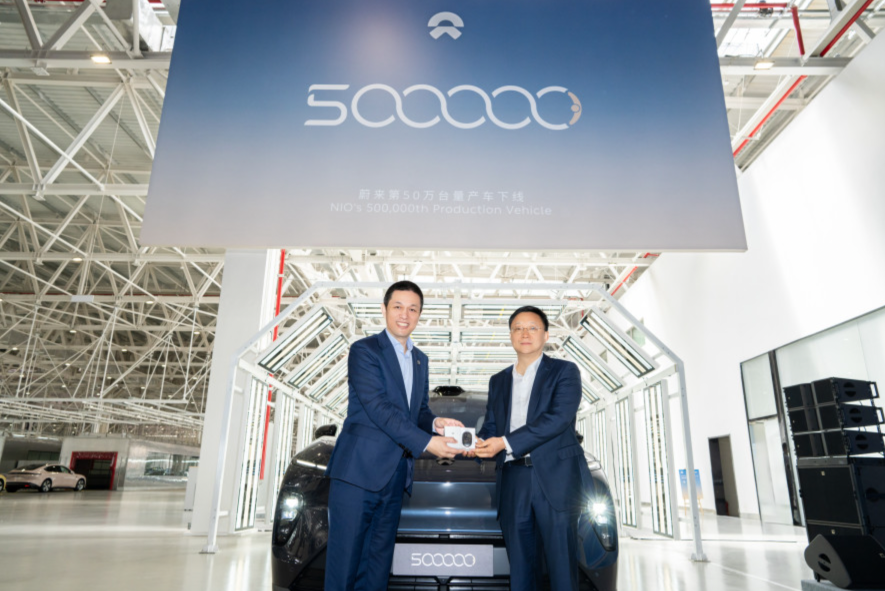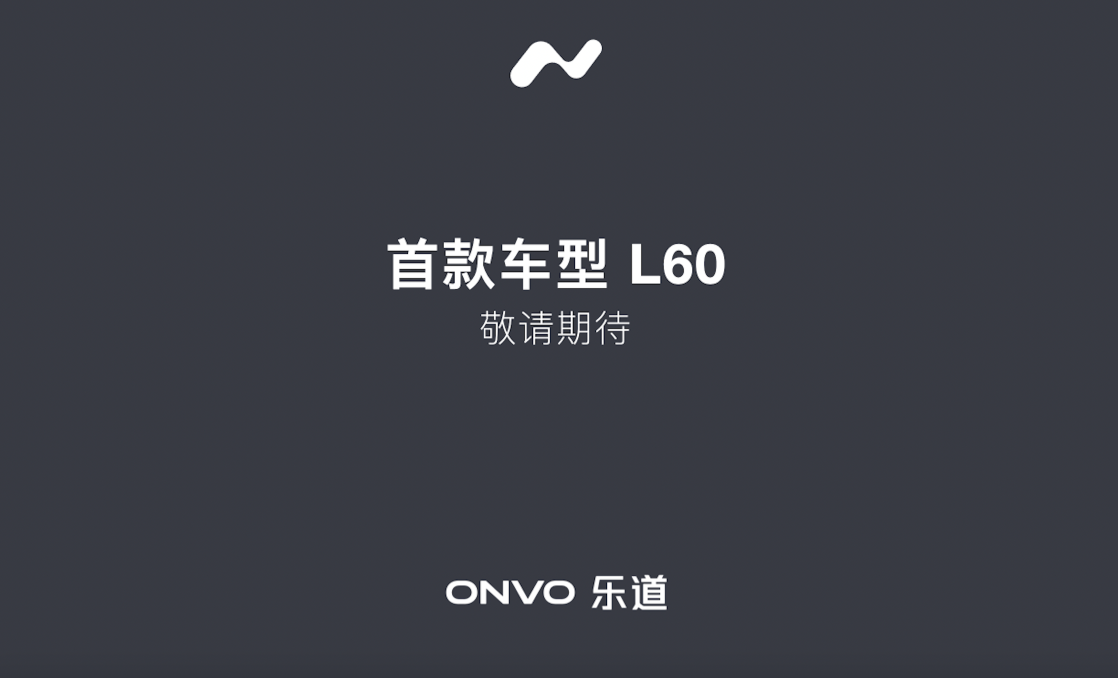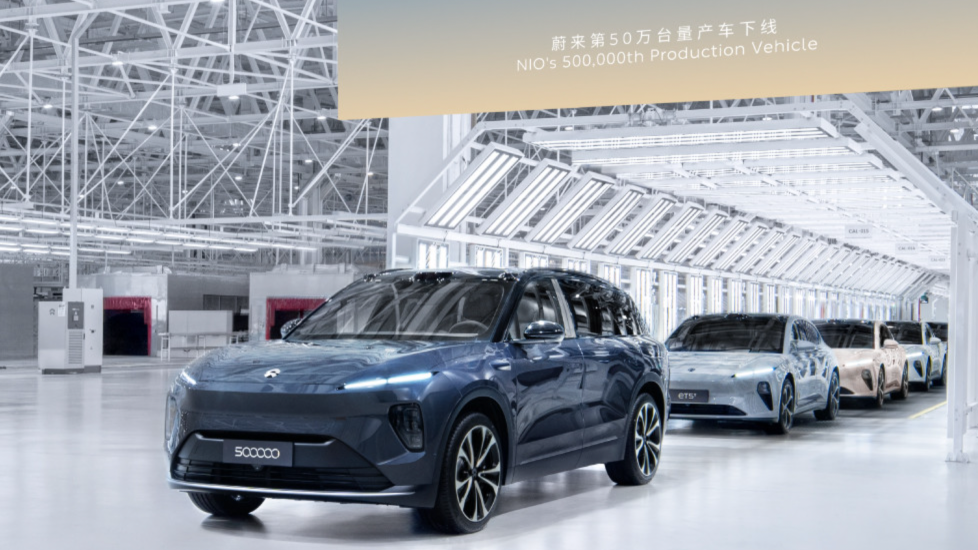NIO, focused on high-end electric vehicles, has finally reached the milestone of the 500,000th mass-produced vehicle off the line.
On May 9th, at NIO’s second factory in the Hefei XinQiao Intelligent Electric Vehicle Industrial Park, Anhui, NIO held the off-line ceremony for its 500,000th mass-produced vehicle, which was none other than the flagship SUV model ES8, priced from 498,000 yuan.
What’s interesting is that, with the offline of NIO’s 500,000th mass-produced vehicle, the launch time of the ONVO brand was officially announced.
At the event, Li Bin, the founder, chairman and CEO of NIO, announced that NIO will launch its second brand “ONVO” on May 15, International Family Day, and use this to accelerate the off-line process of NIO’s 1 million vehicles.
This means that, as a multi-brand stage of the automobile enterprise, NIO will officially kick off in 6 days.
### A virtual ceremony with real significance
For NIO, the offline production of the 500,000th vehicle is undoubtedly a significant milestone. However, as for the specifics of the event, it carries more symbolic meaning.
But the significance and weight behind this symbolism cannot be ignored.
At the event, NIO specially invited the main party and government leaders of Anhui Province and Hefei City to witness. In their speeches, the leaders emphasized the strong momentum of the development of Hefei’s new energy automobile industry, and also declared their unwavering support for companies like NIO to grow stronger.
Li Bin revealed during the communication that the reason they were able to invite these provincial and city leaders was because he “casually mentioned” it during the Anhui-themed day of the Beijing Auto Show and made a request to the leaders, who immediately agreed.
He stressed that this shows the grasp of opportunities in the automobile industry by Anhui Province and Hefei City, and the resulting support for NIO. He also praised the business environment in Anhui Province and Hefei City.
In fact, the significance of staging this event in Hefei, Anhui is profound.
After all, even though NIO was first established in Shanghai, from a production and manufacturing perspective, every mass-produced NIO model is manufactured in Hefei, Anhui. Furthermore, NIO’s two leading smart manufacturing factories and over 120 local industrial chain partners are all in Hefei.
Not only that, when NIO encountered difficulties a few years ago, it was Anhui Province and Hefei City that extended a helping hand. NIO then decided to settle its China headquarters in Hefei, Anhui, which has greatly benefitted the city. This event has become a classic case when outsiders to coin the phrase that Hefei, Anhui, as the “Best VC City”.
Consequently, Li Bin expressed his deepest gratitude to Hefei, Anhui in his speech at the event.
Even though it was an official statement, it was nonetheless genuine.
Other than Anhui Province and Hefei City’s endorsement, Fu Bingfeng, the Executive Vice President and Secretary-General of the China Association of Automobile Manufacturers also stated at the event, “As the representative of China’s high-end new energy vehicle brand, NIO has made proud achievements in leading the market share of high-end electric vehicles, which is very exciting.”As the head of China’s automobile industry association, Fu Bingfeng gave such an evaluation; it is indeed a rare affirmation for NIO.
Additionally, at the event site, NIO also invited over 100 NIO user representatives, including the owner of the 500,000th NIO mass-produced vehicle, who is Liu Qingfeng, the chairman of Sci-tech Innovation Board.

On-site, Li Bin also handed the keys to the 500,000th mass-produced vehicle, a brand new Antarctic Star Blue ES8, to Liu Qingfeng. Liu Qingfeng, a Maybach vehicle owner, stated this is his first new-energy vehicle and praised NIO’s “strategic endurance” in his speech.
Besides the above, one piece of information that gathered significant industry attention during the event was Li Bin’s official announcement: the second brand, ONVO, will be officially launched on International Family Day, May 15th. ONVO brand will be primarily focusing on the family vehicle market, with the connotation of “family joy, housekeeping wisdom”.
Li Bin further highlighted, 500,000 vehicles is a new starting point, and the introduction of the ONVO brand will accelerate the arrival of the next milestone.
### From 1 to 500,000, the ups and downs of NIO’s rhythm
Achieving mass production of 500,000 vehicles in the high-end pure-electric field beyond 300,000 is no easy task—in this process, NIO has also experienced considerable rhythm fluctuations and adjustments.
On May 27, 2018, after being established for three and a half years, NIO saw the first mass-produced vehicle coming offline in Hefei, Anhui. This vehicle was the initial generation NIO’s ES8 model. Within the next couple of years, NIO released the first-generation models of ES6 and EC6 respectively, and successively realized mass production deliveries.
From the perspective of NIO’s development, this period is the building process of NIO’s integrated product system from 0 to 1, and also NIO technical platform’s transition from 1.0 to 2.0. Of course, during this time, NIO as a company also went through a survival crisis and finally survived with the assistance of the Hefei Municipal Government.
Fast forward to April 7, 2021, at JAC NIO Hefei Advanced Manufacturing Base in Hefei, Anhui, NIO Auto welcomed the manufacturing of the 100,000th mass-produced vehicle. This critical juncture, 1,046 days (nearly three years) since NIO’s first mass-produced vehicle was released.
At that time, NIO’s available models consisted of the “866” three models based on the NT1.0 platform. Still, NIO’s first pure electric sedan ET7 based on the NT2.0 platform was officially launched in January of the same year (though it had not yet realized mass production delivery).
In fact, in the whole year of 2021, NIO did not deliver any new products to its users. However, Li Bin stated in his communication session that it was a year NIO “lived quite luxuriously” because of the relatively high gross profit margin, not much loss, and positive operating cash flow.Li Bin emphasized, “At that time, ‘NIO was running at its own pace’”.
A year later, on April 26, 2022, with a NIO ET7 in Antarctic Blue rolling off the production line at the JAC-NIO advanced manufacturing base in Hefei, the 200,000th mass-produced NIO vehicle officially rolled off the line. Thus, NIO became the first automaker among China’s new car manufacturing forces to have 200,000 mass-produced vehicles off their production line.
Just seven months later, on December 12, 2022, NIO’s 300,000th mass-produced vehicle rolled off the line at NIO’s second advanced manufacturing base. This achievement was facilitated by the increased delivery volume of three new models on the NIO NT2.0 platform, the ET7, ES7, and ET5.

By September 8, 2023, NIO’s 400,000th mass-produced vehicle officially rolled off the line. At that point, NIO had essentially completed the launch of the second-generation seven models, and the last model based on the NT2.0 platform, the all-new NIO EC6, officially went on sale seven days later, on September 15.
However, upon reconsidering NIO’s performance in 2022 and 2023, Li Bin was under the impression that NIO didn’t perform well.
As the first and second models on the NT2.0 platform, the NIO ET7 and ET5 could have “soared”, but unfortunately, these two models were seriously affected by the epidemic, especially the ET5, which was lambed right after securing 100,000 orders, as the factory was shut down and the rising cost of batteries led to an increase of thirty to forty thousand yuan per vehicle.
Therefore, Li Bin conceded that, indeed, NIO’s pace over the past two years had been out of sync.
However, NIO began to adjust its rhythm from the second half of 2023. As Li Bin stated, a key point in the adjustment was elevating their sales capacity; by March of this year, with the support of the BaaS policy and the launch of the 2024 models, NIO had entered into an excellent rhythm, making this year a year of great rhythm.
Under such a rhythm, NIO’s sales performance over the last few months maintained steady progress, and it was not until May 9, 2024, after all eight models on the second generation NT2.0 platform officially switched to the 2024 models, that NIO’s 500,000th mass-produced vehicle officially rolled off the line.
In summing up this process, Li Bin said, “From a marathon point of view, what is the best and most comfortable segment? Actually, it is the triumph of rhythm.”
### ONVO is Coming, and NIO is Entering a New Phase
For NIO, as an automaker, 500,000 vehicles is certainly a milestone worth celebrating. But, while celebrating this milestone, NIO has already focused its business on their second brand, ONVO for the remainder of the year.
In fact, prior to this event, a lot of information about the ONVO brand has already been circulating online and has been confirmed or responded to by the official; ONVO’s official website has also been launched and previewed the brand’s first model, the ONVO L60. The news that the ONVO brand will be launched in May is already well known.During this event, a key message that Li Bin attempted to proclaim is that the ONVO brand will officially be launched on International Family Day, May 15th. Choosing International Family Day for the launch demonstrates and emphasizes ONVO’s brand positioning towards family users.
Importantly, in the media communication segment of this event, apart from Li Bin and Qin Lihong, ONVO’s President, Ai Tiecheng, also appeared and discussed some key issues about the ONVO brand.

As for Ai Tiecheng joining NIO, according to Li Bin, considering ONVO’s positioning towards the family market, it was essential to find a leader who deeply understands the meticulous demands of family users. Prior to joining NIO, Ai Tiecheng was the person behind Shanghai Disneyland, fully acquainted with creating joyful family atmospheres.
Therefore, under the invitation of Li Bin, Ai Tiecheng joined NIO, transitioning industries.
In response, Ai Tiecheng stated that he had been in contact with NIO as early as 2015 and became NIO’s 107th car owner. He has a deep understanding of NIO’s users, brand, culture, and experience. He accepted Li Bin’s invitation in 2020 to be responsible for the second brand in NIO, and he has been with NIO for almost four years.
He announced that he will appear at ONVO’s brand launch on May 15th.
Regarding the highly inquired matter of the energy consumption performance of ONVO’s first model, L60, Li Bin emphasizes that unlike the models under NIO, ONVO focuses heavily on energy efficiency. The reason, as explained by Li Bin, is that family cars need to be cost-efficient, and lower energy consumption means saving on electricity bills. This is the strategy behind the ‘household management’ aspect of the product definition.
Li Bin stated that the energy efficiency performance of the ONVO L60 requires considerable technological support, such as the high voltage system, electric drive efficiency, aerodynamic drag, and so on, involving many details.
He stressed that indeed, the energy efficiency performance of the ONVO L60 is aimed to surpass that of Tesla.
When it comes to NIO’s internal positioning of the ONVO brand, Li Bin states that over the past decade, NIO has basically completed the transition from 0 to 1 in terms of product system and technology. The symbol of this achievement is the launch of the NIO ET9. ONVO signifies NIO’s process from 1 to 10, or even 1 to 100, as NIO plans to enter a broader consumer market with ONVO.
Li Bin says NIO has been committed to “dare to take the lead,” including full-stack in-house development, charging and battery swapping systems, global presence, etc.- these are all characteristic of a high-end brand.
Discussing ONVO’s advantages, Li Bin states that ONVO aims to ‘dare to follow,’ applying mature technology and services via cost-effective solutions and reasonable pricing, reaching out to a broader user base. It is not about transitioning from 0 to 1, and naturally, it combines some of NIO’s existing advantages, including NIO’s established battery swapping system and service system.”In this regard, Qin Lihong emphasized that the newly released ONVO brand could enjoy access to over 1,000 battery swap stations; a privilege that many brands lack. Therefore, in terms of the system, its maturity surpasses what others might imagine – the so-called ‘born mature’.”
### In Conclusion
Looking from the perspective of NIO’s overall development, the production of the 500,000th vehicle indeed signifies a transition from past to future.
On one hand, it can be seen as a milestone summary of NIO’s development over the past decade.
Specifically, by targeting a high-end purely electric strategy supported by full-stack proprietary research and a battery swap ecosystem, NIO, through its persistence, has successfully garnered a volume near 500,000 units in the Chinese auto market. This, to a certain extent, has elevated the price range of Chinese domestic brands – and in the high-end purely electric market priced above 300,000, it indeed stands out.

On the other hand, it can also be seen as the starting point for NIO’s next phase. This implies that, with the pivot of the ONVO brand, NIO as a corporation is set to leverage its inherent advantages in technology, product, organisation, and service, entering into a larger market scale with ruthless competition and lower price segments.
This also signifies that NIO will henceforth enter a multi-brand development phase, undeniably a new starting point.
Of course, from a business perspective, an inescapable fact is that beneath the production of these 500,000 vehicles, NIO has invested over 43 billion in R&D over the past 10 years, despite the losses. Now, with the arrival of the ONVO brand, it’s time for NIO to recuperate its investing by seizing a larger market volume.
This article is a translation by AI of a Chinese report from 42HOW. If you have any questions about it, please email bd@42how.com.
